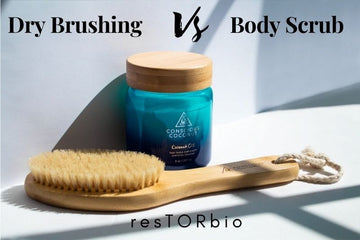
Dry brushing and body scrubbing are two different ways to exfoliate your skin. Dry brushing is the act of brushing your skin with a dry brush, while body scrubbing is the act of using a scrub to remove dead skin cells. Both methods have their own benefits, but dry brushing vs body scrub: which one is right for you?
Dry Brushing Vs Body Scrub

Dry Brushing
Pros Of Dry Body Brushing
You can instantly increase exfoliation and circulation by dry brushing your body with firm, long strokes. The blood will circulate to your skin and you'll feel a tingling. If you rub your hands on your skin, it will become soft. Dry brushing has many benefits.
Dry brushing is believed to improve lymphatic drainage, which is the fluid that removes waste from our skin. This can support detox and optimal health. Skin can lose its glow and be more susceptible to water retention or cellulite.
Regular dry brushing will ensure that your lymph flow is optimally within your body. This may result in skin that is healthier and more toned. Dry brushing is a gentle, calming practice that can be used to promote self-love.
What Should You Look For In A Dry Brush?

It's difficult to choose the right type of body brush because there are so many options. Are they synthetic or natural? Is it wood or plastic? Are you looking for short or long hair? Although synthetic bristles may be more effective in other types, we recommend using natural bristles for your body brushes.
If you are looking for a dry brush, choose one with soft bristles. They won't irritate your skin. The brush should be comfortable to hold and fit comfortably in your hand. For those difficult to reach places, you can get brushes with long handles. Start at your ankles, and move upwards toward your heart with a firm but gentle pressure.
Synthetic bristles can cause minor skin abrasions, but they can also be very sharp. Boar hair and sisal are common body brushes. This is a type of grass, so there will be a natural bristled brush that suits your needs.
You can choose to use wood or plastic at any length you like. It is recommended that you choose one with a long handle to allow you to access difficult areas and to provide enough leverage to make long, firm, but gentle strokes.
It's important to have a handle that is short enough to be easy to use. For clients who are receiving a spa treatment, shorter handles may be better than longer handles. However, for personal use, longer handles will work better.
Drying your body before you take a shower or bath is the best way to brush it. Although different methods are used by different practitioners, a general rule of thumb is that you should brush from the extremities towards the heart using long, firm, yet gentle strokes.
You can brush the outer thighs, belly, and buttocks with gentle circular strokes. Do not brush areas that are damaged, bruised, or have visible spider veins or varicose veins (telangiectasias). A dry brush is not recommended for the breasts or face.
Don't wash the brush after it is done. Instead, tap the brush on a basket to remove any skin cells. Then, store in a dry, closed drawer or cabinet. Microbial contamination can result from heat or humidity. For hygiene reasons, it is important that each household member who uses a brush for their body has his or her own.
It's a good idea to take the brush that was used in a spa treatment with your home as part of your homecare instructions. After dry brushing, take a relaxing bath or shower and massage the skin with aromatherapeutic oil.
How To Use A Dry Brush
You should use body brushing only if you have dry skin.
It is a good rule to brush from the extremities towards the heart in the long, firm, but gentle strokes. You can brush the outer thighs, belly, and buttocks a second time using gentle circular strokes.
Avoid rubbing areas that are damaged, bruised, or have visible spider veins or varicose veins.
Dry brushing is not recommended for people with sensitive skin or skin conditions such as eczema, psoriasis, and excessively dry skin, as it can aggravate the condition—and also cause often painful irritation.
You can gently brush your breast tissue towards your armpit, but avoid touching your nipples. The most congested part of your breast tissue is the one where your bra band/underwire rests.
Body Scrubs
Pros of Body Scrubs

Maintaining smooth and supple skin is one of the most difficult tasks during the winter. Cold winter weather can cause chapped skin. As you age, cell turnover slows down. Your body needs a little extra attention, just as you would scrub your face. Add a body scrub to your skincare routine to get rid of those pesky flakes. It can make your skin feel luxurious and smooth again.
Sugar or other types of salt are the main ingredients in a body scrub or wet exfoliation. They can also be blended with oils like almond, olive, or coconut. Natural fragrances such as essential oils, lemons, and coffee may also be used.
The friction created by the granules being gently massaged on the skin's surface will remove dead cells and flush them away. Massaging oils help to nourish and strengthen the skin's barrier. Gentle massage strokes also improve circulation.
It is also a great way to get the benefits of body scrub in a spa. A body exfoliation might be performed by an aesthetician. This involves dry brushing the skin to stimulate blood flow and lymph. Then, the skin is gently polished and polished while you enjoy the aromatherapy. This can be done at home but it is more effective and provides a deeper level of pampering.
Also read: How To Use Body Scrub?
What should you look for in a body scrub?
The difficulty of selecting a natural scrub depends on the size of the exfoliating grains you prefer and which carrier oils work best for your skin type. You should also consider the scent you like and what price range is most affordable.
- Dead sea salt: This is a coarser, larger option that will give you a deeper, more intense scrub. This is a great option for those with thicker, oilier skin or who want to target rough areas like the heels and elbows. Salt can have detoxifying properties, but it can also be irritating and dry for sensitive skin. You might want to try Pure Fiji's Coconut Crush Scrub, which contains finely ground sugar and crushed coconut shells.
- Cocos Nucifera Shell powder: Cocos Nucifera Shell Powder is a finely ground coconut shell powder. It removes dead/dry skin cells and smoothens and softens skin.
- Sugar: This natural humectant is gentler than salt and makes it a more gentle scrub. Sugar also gives a deeper exfoliation because it dissolves naturally occurring alpha-hydroxy acids, which continue to smooth away dead skin cells and get glowing skin.
- Honey: Provides gentle, enzymatic exfoliation to the most sensitive skin. It also provides antioxidant nourishment.
- Coffee: It is a wonderful picker-upper and has become very popular in scrubs due to its unique ingredients. Coffee is a natural stimulant and is excellent for areas with cellulite. You can make your exfoliating experience more enjoyable by adding chocolate, vanilla, or other scents and oils.
Ingredients and Storage
Pre-made body scrubs should be carefully read and made to suit your skin type. Pure Fiji's Coconut Sugar rub is a good choice for most skin types.
No matter what scrub or rub you use, ensure that you follow the proper storage and use guidelines. Properly store them to avoid possible contamination by bacteria, yeast, and mold if they are exposed to hot shower water.
Keep your body scrub dry in a cool, dry place. Use a dry, scoop-type bowl to get just the right amount to the shower.
How To Choose A Scrub: Sugar vs. Salt Scrubs
Sugar granules can be used on sensitive areas such as the skin. They are less abrasive than salt and are therefore a better choice. Sugar dissolves quickly in water so it is ideal for those who want a gentler scrub. Sugar that has not been refined contains nutrients such as potassium, calcium, and magnesium. This sugar feeds your skin while you scrub. You should not use salt if your skin is damaged.
The most commonly used salt for scrubs is sea salt. It's also a strong exfoliant. Because it is more abrasive than sea salt, it should be used only on the dry parts of your body like your feet, elbows, and legs. Sea salt can pull out toxins from the body and has anti-inflammatory properties for sore muscles. Sugar scrubs are best used once per week. Salt scrubs, however, should be used only once per week.




